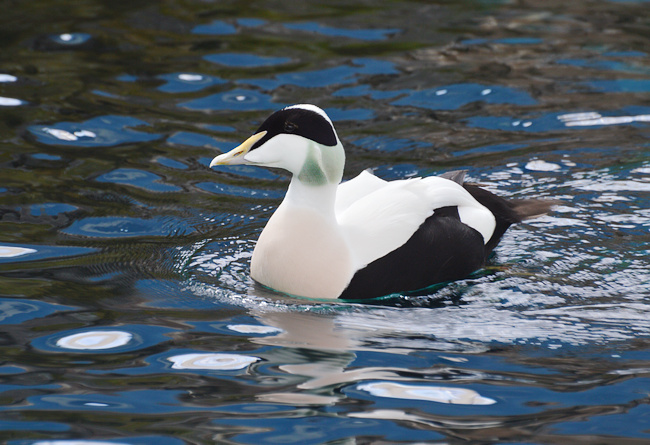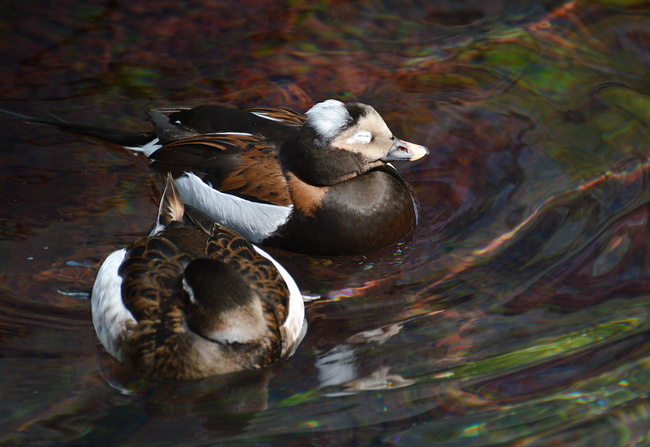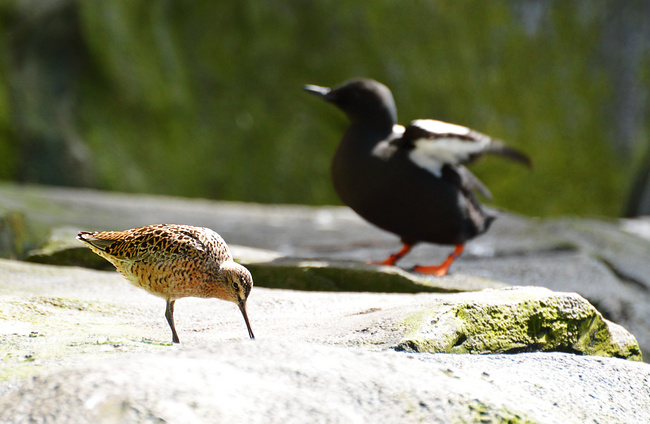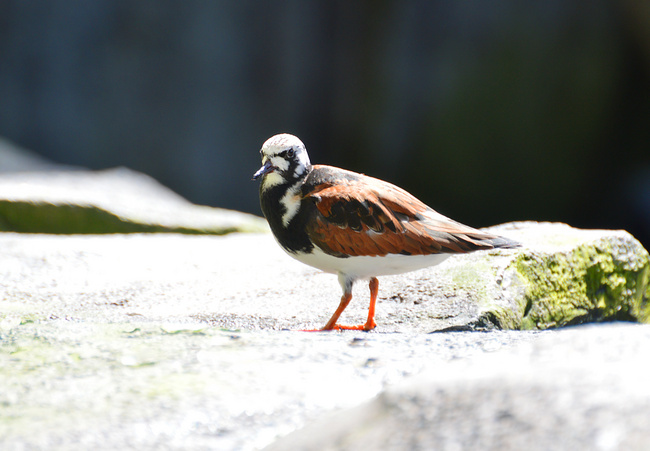
Montreal Biodome 2016 (part 2)
July 4th, 2016
The St. Lawrence marine ecosystem is always my favorite at the Biodome. It is not the only exhibit that puts no barrier between people and creatures, but of them all, it feels the most like being in the wild. Natural light streams in from above, kittiwakes and terns fly back and forth over your head. (People seem to worry about getting pooped on, but I've never seen it happen to anyone.) The ducks there are the kinds of ducks bird-watchers delight in--Harlequins, Eiders, Long-Taileds--and far closer in than we normally get to see them. I feel that I could just sit and soak in the ambience for hours, but my companions always insist on moving on eventually!

Male Common Eider. These handsome fellows are a common sight on the north Atlantic coast. (I lifelisted them in Gaspé, and saw more in Cape Breton last year.) They are also the source of eiderdown, the most expensive and effective down in the world. Since female eiders shed their own down to line their nests with, it can be harvested humanely by simply visiting the nests and gathering the down after the nesting season is over. This is still done today in Iceland.

Long-Tailed Ducks having a nap. This species migrates through Ottawa, but I seldom see them, especially in their handsome breeding plumage.

Amidst the obvious and charismatic birds of the Biodome, there are a number of others that are easily missed. I seem to see something new every time I go there. This was the first time I spotted a Dowitcher (in the foreground above), a type of sandpiper that, like many sandpipers, breeds in the Canadian far north. I didn't recognize it at first until I saw it probing the rocks with a "sewing machine" kind of motion. This is a giveaway for dowitchers mentioned in just about every field guide.
In the backdrop, a Black Guillemot with his trademark bright red feet.

Ruddy Turnstone, an unusually colorful sandpiper. This species occurs wild in Ottawa (in migration), but has eluded me for nine years and counting. A captive bird, of course, cannot go on the lifelist!

Black-Legged Kittiwakes. Kittiwakes look similar to our familiar parking-lot-scavenging Ring-Billed Gulls, but are entirely different in their habits. They are strictly coastal, spend little time around humans, and nest in tiny crevices on sheer cliffs. Baby Kittiwakes have what one website calls "a very strong stay-put instinct." It's a long way down!
Continued in next post...
July 4th, 2016
The St. Lawrence marine ecosystem is always my favorite at the Biodome. It is not the only exhibit that puts no barrier between people and creatures, but of them all, it feels the most like being in the wild. Natural light streams in from above, kittiwakes and terns fly back and forth over your head. (People seem to worry about getting pooped on, but I've never seen it happen to anyone.) The ducks there are the kinds of ducks bird-watchers delight in--Harlequins, Eiders, Long-Taileds--and far closer in than we normally get to see them. I feel that I could just sit and soak in the ambience for hours, but my companions always insist on moving on eventually!

Male Common Eider. These handsome fellows are a common sight on the north Atlantic coast. (I lifelisted them in Gaspé, and saw more in Cape Breton last year.) They are also the source of eiderdown, the most expensive and effective down in the world. Since female eiders shed their own down to line their nests with, it can be harvested humanely by simply visiting the nests and gathering the down after the nesting season is over. This is still done today in Iceland.

Long-Tailed Ducks having a nap. This species migrates through Ottawa, but I seldom see them, especially in their handsome breeding plumage.

Amidst the obvious and charismatic birds of the Biodome, there are a number of others that are easily missed. I seem to see something new every time I go there. This was the first time I spotted a Dowitcher (in the foreground above), a type of sandpiper that, like many sandpipers, breeds in the Canadian far north. I didn't recognize it at first until I saw it probing the rocks with a "sewing machine" kind of motion. This is a giveaway for dowitchers mentioned in just about every field guide.
In the backdrop, a Black Guillemot with his trademark bright red feet.

Ruddy Turnstone, an unusually colorful sandpiper. This species occurs wild in Ottawa (in migration), but has eluded me for nine years and counting. A captive bird, of course, cannot go on the lifelist!

Black-Legged Kittiwakes. Kittiwakes look similar to our familiar parking-lot-scavenging Ring-Billed Gulls, but are entirely different in their habits. They are strictly coastal, spend little time around humans, and nest in tiny crevices on sheer cliffs. Baby Kittiwakes have what one website calls "a very strong stay-put instinct." It's a long way down!
Continued in next post...
| ← | → |

Mike
July 7th, 2016 at 2:47 pm
I do enjoy hanging out there... the cool temperature and open space is really pleasant.
Nice shots, although I suspect my work monitor isn't doing them justice. I think the eider is my favorite!